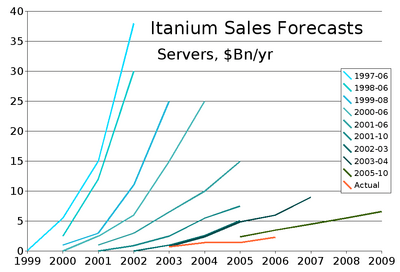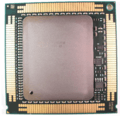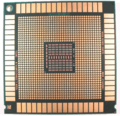Itanium facts for kids

Itanium 2 processor
|
|
| Produced | From mid-2001 to present |
|---|---|
| Common manufacturer(s) |
|
| Max. CPU clock rate | 733 MHz to 2.53 GHz |
| FSB speeds | 300 MHz to 667 MHz |
| Instruction set | Itanium |
| Cores | 1, 2, 4 or 8 |
Itanium (pronounced eye-TAY-nee-əm) was a special type of Intel microprocessor. A microprocessor is like the "brain" of a computer. Itanium chips were designed to be very powerful, especially for big servers, which are computers that store information and run programs for many users.
These chips used a special 64-bit design that was different from the common 64-bit CPUs you find in most computers today. Itanium processors were first created by HP and Intel together. While many companies hoped to use them, mostly HP continued to support systems with these chips. Intel officially stopped making Itanium CPUs on January 30, 2019.
Contents
History
How Itanium Was Developed: 1989–2000
Back in 1989, a company called HP was looking for new ways to make computer processors faster. They wanted to create a chip that could handle many instructions at the same time. This new idea was called Explicitly Parallel Instruction Computing (EPIC). Think of it like a chef who can cook many different dishes at once instead of just one.
EPIC chips used a special way of organizing instructions called very long instruction word (VLIW). This meant that one instruction could actually contain many smaller instructions. The computer's compiler (a program that translates code into instructions the computer understands) would figure out which instructions could run at the same time. This made the processor simpler and helped save energy.
HP didn't want to make these special processors alone. So, in 1994, they teamed up with Intel. Intel hoped that this new design, called IA-64, would become very popular for big computer systems. They worked hard to create the first Itanium chip, code-named "Merced," by 1998.
Many experts believed that IA-64 would be used everywhere, from servers to regular desktop computers. Companies like Compaq and Silicon Graphics even stopped working on their own chip designs to focus on Itanium. Many different operating systems, like Microsoft Windows, Linux, and UNIX versions, were planned for Itanium.
However, making the Itanium chip and its special compilers turned out to be much harder than expected. The chips needed a lot of tiny parts called transistors and large memory areas called caches. Also, the teams from HP and Intel had different ways of working. Because Merced was the first EPIC processor, its creation had many problems.
Intel announced the name Itanium on October 4, 1999. Soon after, some people started calling it Itanic as a joke. This name was a play on the Titanic ship, which was thought to be "unsinkable" but sank. The joke meant that people thought the Itanium project, despite huge investments, would fail.
Itanium (Merced): 2001
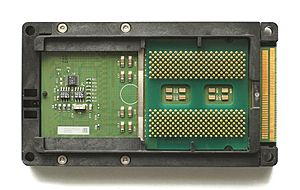
Itanium processor
|
|
| Produced | From June 2001 to June 2002 |
|---|---|
| Common manufacturer(s) |
|
| Max. CPU clock rate | 733 MHz to 800 MHz |
| FSB speeds | 266 MT/s |
| Instruction set | Itanium |
| Cores | 1 |
| L2 cache | 96 KB |
| L3 cache | 2 or 4 MB |
| Socket(s) |
|
| Core name(s) |
|
When the first Itanium chip, "Merced," was released in June 2001, it didn't perform as well as other chips already on the market. It competed with less powerful x86 processors and very powerful chips from companies like IBM and Sun Microsystems. Intel decided to focus Itanium on the high-power business and supercomputing markets.
Only a few thousand "Merced" chips were sold. This was because they didn't perform well, cost a lot, and didn't have much software made for them. Intel realized that Itanium needed more special software to work properly. So, they gave thousands of systems to software companies to help them create programs for Itanium. HP and Intel then released the second Itanium chip, Itanium 2, just a year later.
Itanium 2: 2002–2010

Itanium 2 processor
|
|
| Produced | From 2002 to 2010 |
|---|---|
| Designed by | Intel |
| Common manufacturer(s) |
|
| Max. CPU clock rate | 900 MHz to 2.53 GHz |
| Instruction set | Itanium |
| Cores | 1, 2, 4 or 8 |
| L2 cache | 256 KB on Itanium2 256 KB (D) + 1 MB(I) or 512 KB (I) on (Itanium2 9x00 series) |
| L3 cache | 1.5-32 MB |
| Socket(s) |
|
| Core name(s) |
|
The Itanium 2 processor came out in 2002. It was made for big business servers and powerful computers. The first version of Itanium 2, called McKinley, was much better than the first Itanium. It fixed many problems, especially with how the chip handled memory. McKinley had 221 million transistors, which are tiny switches that make up the chip.
In 2003, another company called AMD released its Opteron chip. This chip used a new design called x86-64, which was an easy upgrade for computers already using x86 chips. Opteron became very popular. Intel later added x86-64 to its own Xeon processors in 2004.
Intel kept improving Itanium 2. In 2003, they released Madison, which used a smaller manufacturing process (130 nanometers). This allowed for more cache memory. Later versions included Montecito (2006), which had two cores and used less energy, and Montvale (2007).
In 2005, the biggest companies that made Itanium servers teamed up with Intel to form the Itanium Solutions Alliance. Their goal was to promote Itanium and help more software work with it. They said they would invest $10 billion in Itanium by the end of the decade.
Itanium 9300 (Tukwila): 2010
The Itanium 9300 series processor, code-named Tukwila, was released on February 8, 2010. It offered even better performance and could handle more memory.
Tukwila was made using a 65-nanometer process. It had between two and four cores (like mini-brains inside the main chip) and up to 24 MB of CPU cache (fast memory). It also had Hyper-Threading technology, which helps the chip do more tasks at once, and new memory controllers. Tukwila also used a new way for parts of the computer to talk to each other, called Intel QuickPath Interconnect (QPI), which replaced the older Itanium bus. This QPI system allowed the processor to talk to other processors and memory very quickly.
Itanium 9500 (Poulson): 2012
The Itanium 9500 series processor, code-named Poulson, came out on November 8, 2012. It was an even more advanced chip. Intel skipped some older manufacturing steps and made Poulson using a 32-nanometer process. This chip had 8 cores and could handle many instructions at once. It also had improved multi-threading and new instructions to help with virtualization (running multiple operating systems on one computer).
Poulson had a large L3 cache of 32 MB. Its L2 cache was 6 MB, with 512 KB for instructions and 256 KB for data per core. Even with more features, Poulson was smaller than Tukwila.
Here are some of the Itanium 9500 series models:
| Processor number | Frequency |
|---|---|
| 9520 | 1.73 GHz |
| 9540 | 2.13 GHz |
| 9550 | 2.4 GHz |
| 9560 | 2.53 GHz |
Compared to Intel's popular Xeon server processors, Itanium was never a huge product for Intel. Intel didn't share exact sales numbers. One expert guessed that about 200,000 Itanium processors were made each year in 2007.
In 2007, about 55,000 Itanium servers were sold by all companies. To compare, 417,000 RISC servers and 8.4 million x86 servers were sold in the same year. From 2001 to 2007, about 184,000 Itanium-based systems were sold in total.
By 2007, HP sold about 80% of all Itanium systems. By 2008, HP's share grew to 95% of Itanium sales. Most Itanium systems were sold as powerful enterprise servers or for very large technical computing tasks. Each system could cost around $200,000 and often used eight or more Itanium processors.
In 2012, a report said that Itanium server shipments would stay low, with about 26,000 systems shipped each year until 2016. This was a big drop from sales in 2008.
Hardware Support
Systems
| Company | Latest product | |||
|---|---|---|---|---|
| name | from | to | name | CPUs |
| Compaq | 2001 | 2001 | ProLiant 590 | 1–4 |
| IBM | 2001 | 2005 | x455 | 1–16 |
| Dell | 2001 | 2005 | PowerEdge 7250 | 1–4 |
| Hitachi | 2001 | 2008 | BladeSymphony 1000 |
1–8 |
| Unisys | 2002 | 2009 | ES7000/one | 1–32 |
| SGI | 2001 | 2011 | Altix 4000 | 1–2048 |
| Fujitsu | 2005 | 2011 | PRIMEQUEST | 1–32 |
| HP | 2001 | now | Integrity | 1–256 |
| Bull | 2002 | now | NovaScale 9410 | 1–32 |
| NEC | 2002 | now | nx7700i | 1–256 |
| Inspur | 2010 | now | TS10000 | 2-1024 |
| Huawei | 2012 | now | ???? | ???? |
As of 2015, only a few companies still made systems that used Itanium chips. These included HP, Bull, NEC, Inspur, and Huawei. Intel also offered parts that other companies could use to build Itanium systems.
HP was the main company selling Itanium systems, making at least 80% of them. In the first three months of 2006, HP sold 7,200 Itanium systems.
Chipsets
The "chipset" is like a traffic controller that helps the Itanium processor talk to the rest of the computer, like memory and other parts. Companies that made enterprise servers often created their own chipsets to make their systems unique. Making a chipset costs a lot of money, showing a big commitment to using Itanium.
While IBM and Intel made chipsets in the past, they didn't update them for newer technologies. Today, modern chipsets for Itanium that support newer technologies are made by HP, Fujitsu, SGI, NEC, and Hitachi.
The "Tukwila" Itanium processor was designed to share a common chipset with Intel's Xeon processors. The idea was to make it easier and cheaper for companies to build both Itanium and Xeon servers. However, this goal was later put on hold.
Software Support
Itanium chips could run several operating systems, though support for some has ended:
- HP-UX 11i
- Windows family (support ended with Windows Server 2008 R2)
- Windows XP 64-Bit Edition (no longer supported)
- Windows Server 2003 (no longer supported)
- Windows Server 2008 (limited support until January 2020)
- Windows Server 2008 R2 (the last Windows version to support Itanium)
- Linux distributions
- Gentoo
- SUSE's SLES (no longer supported after SLES 11 SP4)
- TurboLinux (the first Linux to support Itanium in 2001)
- FreeBSD (no longer supported)
- NetBSD (only in development, no official release)
- OpenVMS I64 (supported until 2020)
- NonStop OS
- Bull GCOS 8
- NEC ACOS-4
Microsoft announced that Windows Server 2008 R2 would be the last version of Windows Server to support Itanium. They also stopped making Itanium versions of their software development tools (like Visual Studio) and database software (like SQL Server).
Similarly, Red Hat Enterprise Linux 5 was the last Itanium version from Red Hat. Debian also no longer officially supports Itanium.
To help more software work on Itanium, Intel supported the creation of special compilers (programs that translate code). The GCC and Open64 compilers could also create code for Itanium. In early 2008, the Itanium Solutions Alliance said that over 13,000 applications were available for Itanium systems.
Emulation
Emulation is a way for a computer to run software that was made for a different type of computer. For example, some software made for older systems could run on Itanium using a type of emulation called "dynamic binary translation." HP also used emulation to help its customers move their old software to Itanium systems. Itanium processors could also run some x86 operating systems using special instruction set simulators.
Competition
Itanium was designed for powerful enterprise servers and high-performance computing (HPC) markets. Other chips in this market included Oracle Corporation's SPARC and IBM's POWER8. However, Itanium's biggest competition came from x86-64 processors, including Intel's own Xeon chips and AMD's Opteron chips. Since 2009, most servers were being sold with x86-64 processors.
In 2005, Itanium systems made up about 14% of the money earned from HPC systems. But this percentage went down as more people started using x86-64 clusters for these powerful computers.
Supercomputers and High-Performance Computing
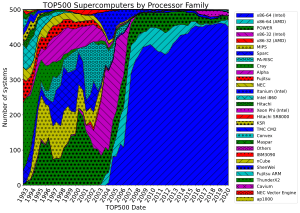
An Itanium-based computer first appeared on the list of the TOP500 supercomputers in November 2001. The highest an Itanium 2 system ever ranked was #2 in June 2004. This was when a supercomputer called Thunder (at LLNL) joined the list. Another supercomputer, Columbia, also reached #2 in November 2004.
The most Itanium-based machines on the TOP500 list was in November 2004, with 84 systems. But by June 2012, only one Itanium system remained on the list. By November 2012, there were no Itanium systems left on the TOP500 list.
Processors
Released Processors
The Itanium processors improved over time. The first one, Merced, was just a test. McKinley greatly improved how it handled memory, making Itanium more competitive. Madison, made with a smaller 130-nanometer process, allowed for more cache memory, which helped with performance. Montecito, using a 90-nanometer process, had two cores and used less power. Montvale added new features like better core control and faster bus speeds.
| Codename | Process | Released | Clock Speed | L2 Cache/ core |
L3 Cache/ processor |
Bus Speed | Dies/ device |
Cores/ die |
Power (watts)/ device |
Notes |
|---|---|---|---|---|---|---|---|---|---|---|
| Itanium | ||||||||||
| Merced | 180 nm | 2001-06 | 733 MHz | 96 KB | none | 266 MHz | 1 | 1 | 116 | 2 MB separate L3 cache |
| 800 MHz | 130 | 4 MB separate L3 cache | ||||||||
| Itanium 2 | ||||||||||
| McKinley | 180 nm | 2002-07-08 | 900 MHz | 256 KB | 1.5 MB | 400 MHz | 1 | 1 | 130 | Improved branch prediction |
| 1 GHz | 3 MB | 130 | ||||||||
| Madison | 130 nm | 2003-06-30 | 1.3 GHz | 3 MB | 130 | |||||
| 1.4 GHz | 4 MB | 130 | ||||||||
| 1.5 GHz | 6 MB | 130 | ||||||||
| 2003-09-08 | 1.4 GHz | 1.5 MB | 130 | |||||||
| 2004-04 | 1.4 GHz | 3 MB | 130 | |||||||
| 1.6 GHz | ||||||||||
| Deerfield | September 8, 2003 | 1.0 GHz | 1.5 MB | 62 | Low power version | |||||
| Hondo | 2004-Q1 | 1.1 GHz | 4 MB | 400 MHz | 2 | 1 | 260 | 32 MB L4 cache | ||
| Fanwood | 2004-11-08 | 1.6 GHz | 3 MB | 533 MHz | 1 | 1 | 130 | |||
| 1.3 GHz | 400 MHz | 62? | Low power version | |||||||
| Madison | November 8, 2004 | 1.6 GHz | 9 MB | 400 MHz | 130 | |||||
| 2005-07-05 | 1.67 GHz | 6 MB | 667 MHz | 130 | ||||||
| 2005-07-18 | 1.67 GHz | 9 MB | 667 MHz | 130 | ||||||
| Itanium 2 9000 series | ||||||||||
| Montecito | 90 nm | 2006-07-18 | 1.4 GHz | 256 KB (D)+ 1 MB (I) |
6–24 MB | 400 MHz | 1 | 2 | 104 | Virtualization, Multithreading |
| 1.6 GHz | 533 MHz | |||||||||
| Itanium 2 9100 series | ||||||||||
| Montvale | 90 nm | October 31, 2007 | 1.42–1.66 GHz | 256 KB (D)+ 1 MB (I) |
8–24 MB | 400–667 MHz | 1 | 1–2 | 75–104 | Core-level lockstep, demand-based switching |
| Itanium 9300 series | ||||||||||
| Tukwila | 65 nm | February 8, 2010 | 1.33–1.73 GHz | 256 KB (D)+ 512 KB (I) |
10–24 MB | QPI with a speed of 4.8 GT/s | 1 | 2–4 | 130–185 | New QPI bus, Turbo Boost |
| Itanium 9500 series | ||||||||||
| Poulson | 32 nm | 2012-11-08 | 1.73–2.53 GHz | 256 KB (D)+ 512 KB (I) |
20–32 MB | QPI with a speed of 6.4 GT/s | 1 | 4–8 | 130–170 | More instructions per cycle, Instruction Replay, improved hyperthreading |
| Codename | Process | Released | Clock Speed | L2 Cache/ core |
L3 Cache/ processor |
Bus Speed | Dies/ device |
Cores/ die |
Power (watts)/ device |
Notes |
Future Processors
Court documents showed that HP paid Intel a lot of money to keep making and updating Itanium chips. This deal meant Intel would continue to make Itanium chips for HP's computers until 2017. Under these agreements, Intel planned to release new chips like Tukwila, Poulson, and Kittson to make the platform better.
Kittson
Kittson was planned to follow Poulson in 2015. Like Poulson, Kittson was going to be made using Intel's 32-nanometer process. Not many details were known about Kittson, except that it would work with Poulson and Tukwila.
Timeline
- 1989:
- HP starts looking into EPIC technology.
- 1994:
- June: HP and Intel announce they will work together.
- 1997:
- June: A company called IDC predicts that IA-64 systems will sell for $38 billion a year by 2001.
- 1998:
- June: Intel announces that the first Itanium chip, Merced, will be delayed.
- 1999:
- October: Intel announces the name Itanium.
- October: The joke name Itanic is first used.
- 2000:
- August: AMD releases details for x86-64, a new 64-bit design that would compete with Itanium.
- 2001:
- July: The first Itanium chip is released.
- November: An IBM supercomputer with 320 Itanium processors is listed among the world's fastest.
- 2002:
- June: Itanium 2 is released, which is much better than the first Itanium.
- 2003:
- April: AMD releases Opteron, the first chip with x86-64 extensions, which becomes very popular.
- June: Intel releases the "Madison" Itanium 2.
- 2004:
- June: Intel releases its first Xeon processor with x86-64 extensions.
- June: Thunder, a supercomputer with 4096 Itanium 2 processors, becomes the second fastest in the world.
- November: Columbia, another supercomputer with 10160 Itanium 2 processors, also ranks as the second fastest.
- 2005:
- September: The Itanium Solutions Alliance is formed to support Itanium.
- September: Dell stops selling Itanium computers.
- 2006:
- June: Intel releases the dual-core "Montecito" Itanium 2 9000 series.
- 2007:
- October: Intel releases the "Montvale" Itanium 2 9100 series.
- November: Intel changes the family name back to Itanium.
- 2009:
- December: Red Hat announces it will stop supporting Itanium in its next operating system.
- 2010:
- February: Intel announces the "Tukwila" Itanium 9300 series.
- April: Microsoft announces it will gradually stop supporting Itanium.
- 2011:
- March: Oracle Corporation announces it will stop making software for Itanium.
- March: Intel and HP say they will continue to support Itanium.
- 2012:
- September: After a court ruling, Oracle starts supporting Itanium software again.
- 2013:
- November: HP announces that its NonStop servers will start using Intel 64 (x86-64) chips instead of Itanium.
- 2014:
- December: HP announces that its next big servers will use Intel Xeon processors, marking the end of an era for Itanium in their new products.
Images for kids
See also
 In Spanish: Intel Itanium para niños
In Spanish: Intel Itanium para niños


